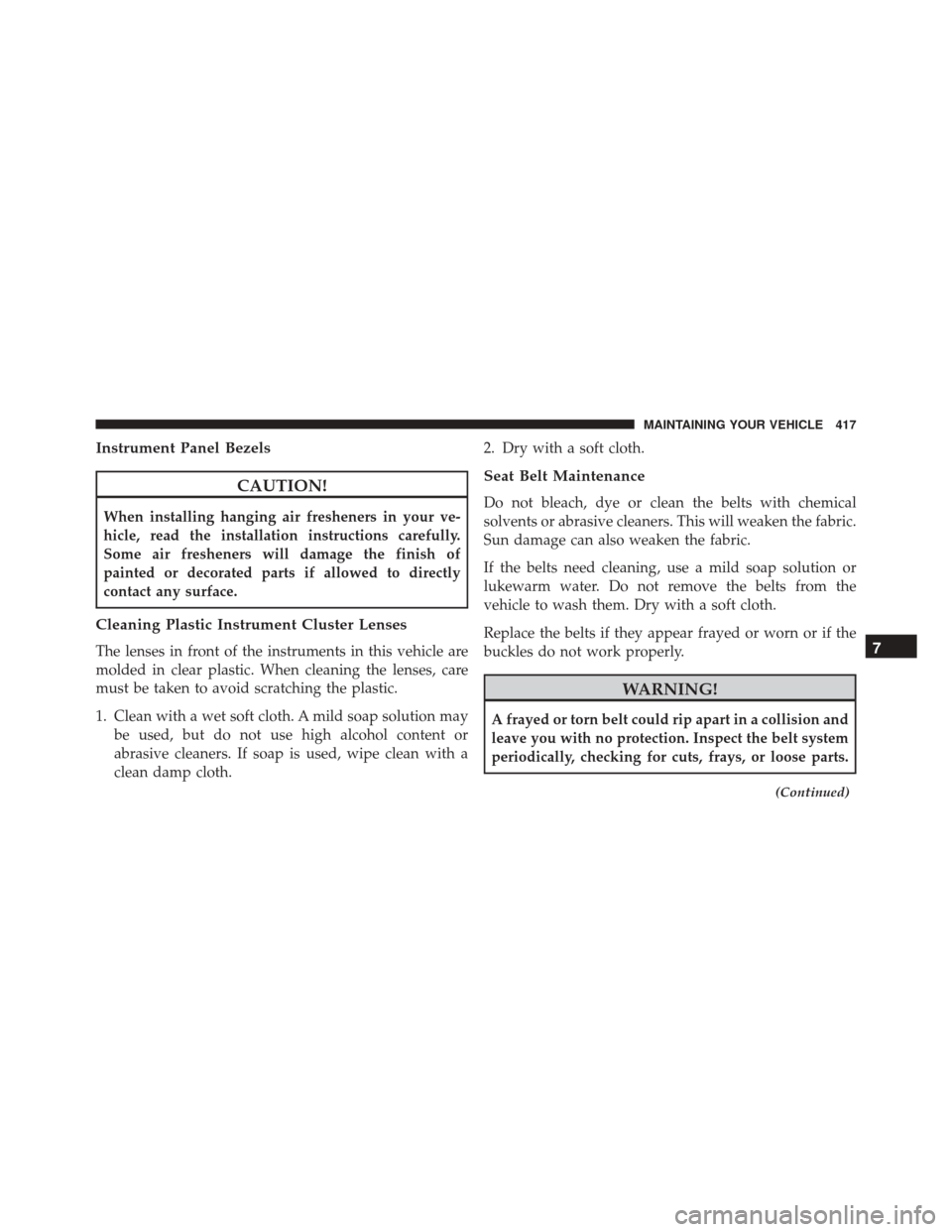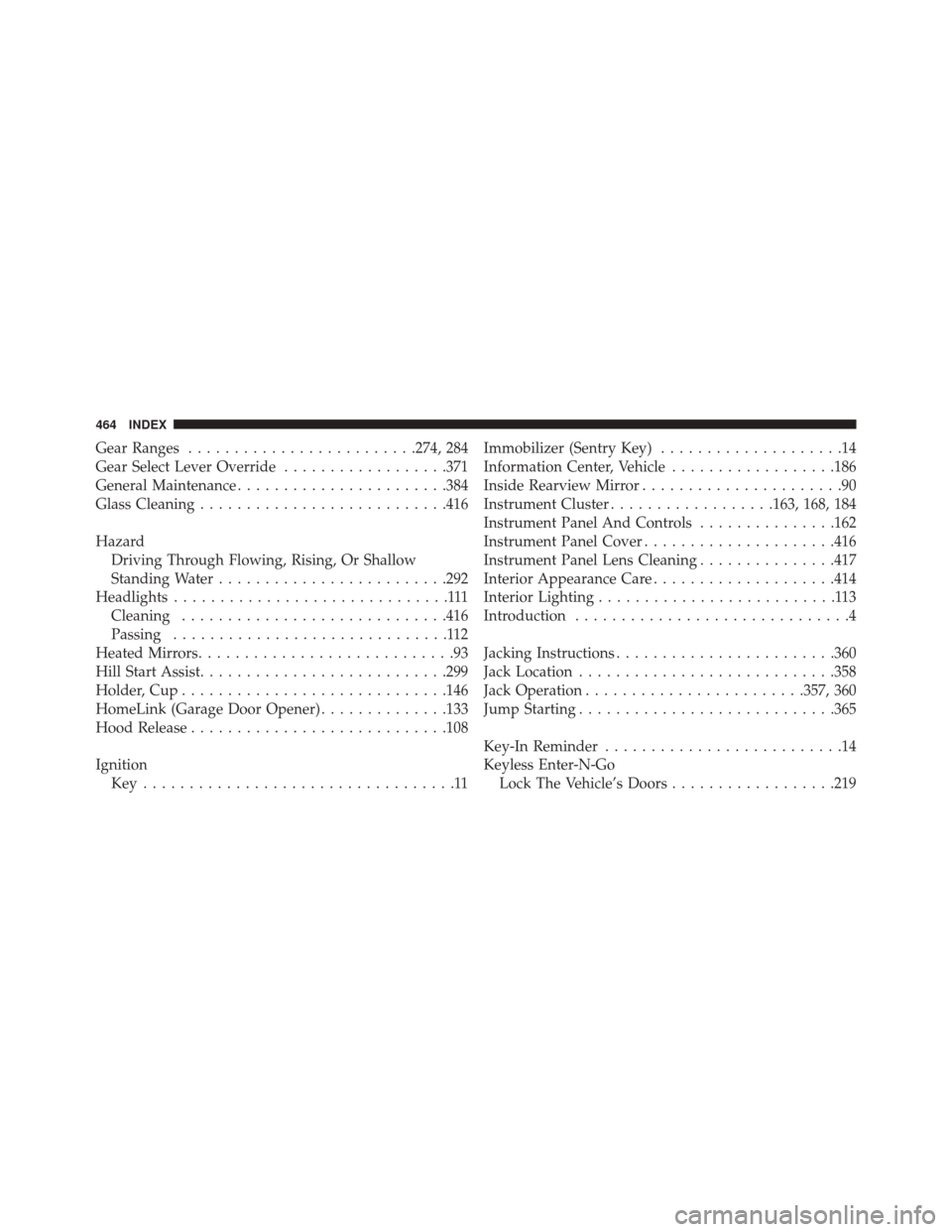2016 FIAT 500L instrument cluster
[x] Cancel search: instrument clusterPage 305 of 476

on after several ignition cycles, and the vehicle has been
driven several miles (kilometers) at speeds greater than
30 mph (48 km/h), see your authorized dealer as soon as
possible to have the problem diagnosed and corrected.
The ESC Activation/Malfunction Indicator Light (located
in the instrument cluster) starts to flash as soon as the
tires lose traction and the ESC system becomes active.
The ESC Activation/Malfunction Indicator Light also
flashes when TCS is active. If the ESC Activation/
Malfunction Indicator Light begins to flash during accel-
eration, ease up on the accelerator and apply as little
throttle as possible. Be sure to adapt your speed and
driving to the prevailing road conditions.
NOTE:
•The ESC Activation/Malfunction Indicator Light and
the ESC OFF Indicator Light come on momentarily
each time the ignition switch is turned ON. •
Each time the ignition is turned ON, the ESC system
will be ON even if it was turned off previously.
The ESC OFF Indicator Light indicates the
Electronic Stability Control (ESC) is partially
off or full off.
ESC Operating Modes
The ESC system has two available operating modes.
Full On
This is the normal operating mode for ESC. Whenever
the vehicle is started the system will be in this mode. This
mode should be used for most driving situations. ESC
should only be turned to “Partial Off” for specific reasons
as noted. Refer to “Partial Off” for additional informa-
tion.
5
STARTING AND OPERATING 303
Page 337 of 476

CAUTION!(Continued)
stem, which could damage the Tire Pressure Moni-
toring Sensor.
NOTE:
• The TPMS is not intended to replace normal tire care
and maintenance, or to provide warning of a tire
failure or condition.
• The TPMS should not be used as a tire pressure gauge
while adjusting your tire pressure.
• Driving on a significantly under-inflated tire causes
the tire to overheat and can lead to tire failure.
Under-inflation also reduces fuel efficiency and tire
tread life, and may affect the vehicle’s handling and
stopping ability.
• The TPMS is not a substitute for proper tire mainte-
nance, and it is the driver ’s responsibility to maintain correct tire pressure using an accurate tire gauge, even
if under-inflation has not reached the level to trigger
illumination of the Tire Pressure Monitoring Telltale
Light.
• Seasonal temperature changes will affect tire pressure,
and the TPMS will monitor the actual tire pressure in
the tire.
Base System
This is the TPMS warning indicator located in the
instrument cluster.
The TPMS uses wireless technology with wheel rim
mounted electronic sensors to monitor tire pressure lev-
els. Sensors, mounted to each wheel as part of the valve
stem, transmit tire pressure readings to the Receiver
Module.
5
STARTING AND OPERATING 335
Page 338 of 476

NOTE:It is particularly important for you to check the
tire pressure in all of the tires on your vehicle regularly
and to maintain the proper pressure.
The TPMS consists of the following components:
• Receiver Module.
• Four Tire Pressure Monitoring Sensors.
• Tire Pressure Monitoring Telltale Light.
Tire Pressure Monitoring Low Pressure Warnings
The Tire Pressure Monitoring Telltale Light will illumi-
nate in the instrument cluster, an acoustic signal will be
activated, and the “Check left or right front/rear tire”
text message will display when one or more of the four
active road tire pressures are low. Should this occur, you
should stop as soon as possible, check the inflation
pressure of each tire on your vehicle, and inflate each tire
to the vehicle’s recommended cold placard pressure
value. The system will automatically update and the Tire Pressure Monitoring Light will extinguish once the up-
dated tire pressures have been received. The vehicle may
need to be driven for up to 20 minutes above 15 mph
(24 km/h) to receive this information.
Check TPMS Warnings
The Tire Pressure Monitoring Telltale Light will flash on
and off for 75 seconds and remain on solid when a system
fault is detected, an audible chime will be activated and
the “Service Tire Pressure Monitoring System” text mes-
sage will display. If the ignition key is cycled, this
sequence will repeat providing the system fault still
exists. The Tire Pressure Monitoring Telltale Light will
turn off when the fault condition no longer exists. A
system fault can occur with any of the following sce-
narios:
•
Jamming due to electronic devices or driving next to
facilities emitting the same radio frequencies as the
TPM sensors.
336 STARTING AND OPERATING
Page 352 of 476

supplement to the radiator and aids in removing heat
from the engine cooling system.
CAUTION!
Driving with a hot cooling system could damage
your vehicle. If the pointer rises to the H (red) mark,
the instrument cluster will sound a chime. When
safe, pull over and stop the vehicle with the engine at
idle. Turn off the air conditioning and wait until the
pointer drops back into the normal range. If the
pointer remains on the H (red) mark for more than a
minute, turn the engine off immediately and call for
service.
WARNING!
You or others can be badly burned by hot engine
coolant (antifreeze) or steam from your radiator. If
you see or hear steam coming from under the hood,
do not open the hood until the radiator has had time
to cool. Never try to open a cooling system pressure
cap when the radiator or coolant bottle is hot.
WHEEL AND TIRE TORQUE SPECIFICATIONS
Proper lug nut/bolt torque is very important to ensure
that the wheel is properly mounted to the vehicle. Any
time a wheel has been removed and reinstalled on the
vehicle the lug nuts/bolts should be torqued using a
properly calibrated torque wrench.
350 WHAT TO DO IN EMERGENCIES
Page 419 of 476

Instrument Panel Bezels
CAUTION!
When installing hanging air fresheners in your ve-
hicle, read the installation instructions carefully.
Some air fresheners will damage the finish of
painted or decorated parts if allowed to directly
contact any surface.
Cleaning Plastic Instrument Cluster Lenses
The lenses in front of the instruments in this vehicle are
molded in clear plastic. When cleaning the lenses, care
must be taken to avoid scratching the plastic.
1. Clean with a wet soft cloth. A mild soap solution maybe used, but do not use high alcohol content or
abrasive cleaners. If soap is used, wipe clean with a
clean damp cloth. 2. Dry with a soft cloth.
Seat Belt Maintenance
Do not bleach, dye or clean the belts with chemical
solvents or abrasive cleaners. This will weaken the fabric.
Sun damage can also weaken the fabric.
If the belts need cleaning, use a mild soap solution or
lukewarm water. Do not remove the belts from the
vehicle to wash them. Dry with a soft cloth.
Replace the belts if they appear frayed or worn or if the
buckles do not work properly.
WARNING!
A frayed or torn belt could rip apart in a collision and
leave you with no protection. Inspect the belt system
periodically, checking for cuts, frays, or loose parts.
(Continued)
7
MAINTAINING YOUR VEHICLE 417
Page 466 of 476

Gear Ranges........................ .274, 284
Gear Select Lever Override ..................371
General Maintenance ...................... .384
Glass Cleaning .......................... .416
Hazard Driving Through Flowing, Rising, Or Shallow
Standing Water ........................ .292
Headlights ..............................111
Cleaning ............................ .416
Passing ..............................112
Heated Mirrors ............................93
Hill Start Assist .......................... .299
Holder, Cup ............................ .146
HomeLink (Garage Door Opener) ..............133
Hood Release ........................... .108
Ignition Key..................................11 Immobilizer (Sentry Key)
....................14
Information Center, Vehicle ..................186
Inside Rearview Mirror ......................90
Instrument Cluster ..................163, 168, 184
Instrument Panel And Controls ...............162
Instrument Panel Cover .....................416
Instrument Panel Lens Cleaning ...............417
Interior Appearance Care ....................414
Interior Lighting ..........................113
Introduction ..............................4
Jacking Instructions ....................... .360
Jack Location ........................... .358
Jack Operation ....................... .357, 360
Jump Starting ........................... .365
Key-In Reminder ..........................14
Keyless Enter-N-Go Lock The Vehicle’s Doors ..................219
464 INDEX
Page 467 of 476

Passive Entry Programming................219
Unlock Liftgate ........................ .219
Key, Replacement ..........................15
Keys ...................................11
Key, Sentry (Immobilizer) ....................14
Lane Change Assist ........................112
Lap/Shoulder Belts .........................34
Latches .................................85
Lead Free Gasoline ....................... .338
Leaks, Fluid ..............................85
Life Of Tires ............................ .328
Liftgate (Sedan) ...........................29
Light Bulbs .......................... .85, 428
Lighter, Cigar ........................... .145
Lights ........................... .85, 110, 111
AirBag .........................56, 83, 170
Brake Assist Warning ....................302
Brake Warning ........................ .166Bulb Replacement
...................... .430
Center Mounted Stop ....................434
Cruise .............................. .185
Engine Temperature Warning ...............168
Exterior ...............................85
Low Fuel ............................ .177
Malfunction Indicator (Check Engine) .........178
Park .............................112,185
Passing ..............................112
Seat Belt Reminder ..................... .169
Security Alarm ..........................16
Service .............................. .430
Tire Pressure Monitoring (TPMS) ............180
Traction Control ....................... .302
Turn Signal ........................ .85, 184
Warning (Instrument Cluster Description) . . .168, 184
Loading Vehicle Tires ............................... .313
10
INDEX 465